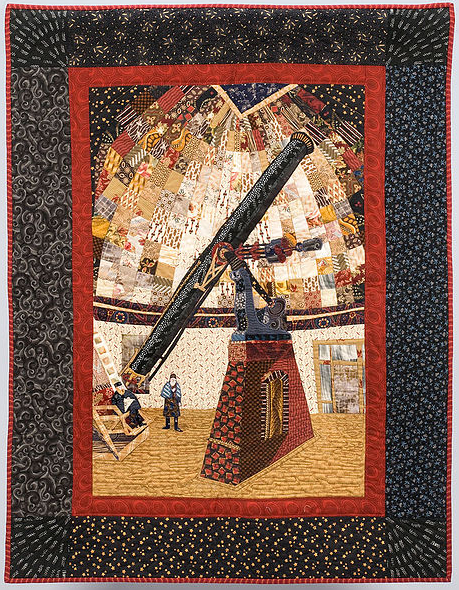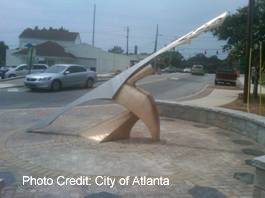- Details
- Hits: 8335
Want to travel? Want to see sundials? Well, you can do both by taking a virtual tour of the Galileo Museum (Museo Galileo) in Florence, Italy. Beside showing you detailed sundials, astrolabes, and quadrants in their collection, they host a series of short 2 minute videos on sundials and many other topics.
This is a fun virtual site to explore: https://catalogue.museogalileo.it/ Here you can read about the biography of Galileo or many other famous scientists or you may want to browse many of 1000 astronomical instruments in their collection, or watch a video on Galileo's astronomy or see how the the heavens can be seen in the armillary sphere sundial, or consider the history of the lightning rod with a demostration of gunpowder blowing apart a small wooden house (called a "Thunder House") that doesn't have one.
There are many short videos about sundials and astrolabes. And of course there is the Monumental Sundial at the entrance to Museo Galileo. Click here to watch a short animation of how this gnomonic sundial works. The Museum has many of these instructional videos. Be sure to visit their video catalogue: https://catalogue.museogalileo.it/index/VideoIndexByThematicArea.html
- Details
- Hits: 15489
.jpeg) 1918 Photo of Camp Brooks Open-Air Hospital Boston - Nat'l Archives 1918 Photo of Camp Brooks Open-Air Hospital Boston - Nat'l Archives |
We feel the menance of the Corona Virus (Covid-19) and the imposed social isolation. Although worse than the typical annual flu, the Corona Virus pales to the worldwide pandemic of the Spanish Flu (isolated as the H1N1 virus). What does this have to do with sunlight? I am indebted to Richard Hobday's well researched article:
Here is his paragraph on "Sunlight and Influenza Infection"
"Putting infected patients out in the sun may have helped because it inactivates the influenza virus.[7] It also kills bacteria that cause lung and other infections in hospitals.[8] During the First World War, military surgeons routinely used sunlight to heal infected wounds.[9] They knew it was a disinfectant. What they didn’t know is that one advantage of placing patients outside in the sun is they can synthesise vitamin D in their skin if sunlight is strong enough. This was not discovered until the 1920s. Low vitamin D levels are now linked to respiratory infections and may increase susceptibility to influenza.[10] Also, our body’s biological rhythms appear to influence how we resist infections.[11] New research suggests they can alter our inflammatory response to the flu virus.[12] As with vitamin D, at the time of the 1918 pandemic, the important part played by sunlight in synchronizing these rhythms was not known."
- Details
- Hits: 15900
 Sundials are often created at the instersection of science and art. Quilting has made its mark as well. For example in Burnsville North Carolina is the Quilt Block Sundial, painted in bright quilt blocks on a 8x8 foot board above the entrance to the Yancy Common Times Journal Building.
Sundials are often created at the instersection of science and art. Quilting has made its mark as well. For example in Burnsville North Carolina is the Quilt Block Sundial, painted in bright quilt blocks on a 8x8 foot board above the entrance to the Yancy Common Times Journal Building.
Now comes Altazimuth Arts, an enterprise established by Sara Schechner, well-know historian of science who is curator of Harvard's Collection of Historic Scientific Instruments. But Schechner is also active in the Studio Art Quilt Associates, Quilters' Connection of Watertown MA, and member of Quinobeguin Quilters guild. As she explains, "Recent quilts are inspired by history and the night sky, the built environment wet within nature, and by the many-faceted meanings of tangible things."
Illustrated is the US Naval Observatory 26-inch refractor made by Alvan Clark & Sons in 1873. "The inspiration for my quilt was an engraving from a newspaper story celebrating the work of the telescope. The print shows astronomer Simon Newcomb (at the eyepiece) and Superintendent Rear Admiral Benjamin F. Sands (standing) in the dome with the brand new telescope in late fall 1873. The engraving was based on a photograph of the same scene." Visit Schechner site at www.altazimutharts.com
- Details
- Hits: 18163
 Frank Cousins in the appendix of his book Sundials includes a list of references to sundials in Shakespeare. Mechanical timepieces were extremely rare in Shakespeare's day. Cousins credits the list to Professor Delius, The Leopold Shakespeare, Cassel. London, 1887. Here are the full citations taken from the online Complete Works of William Shakespeare.
Frank Cousins in the appendix of his book Sundials includes a list of references to sundials in Shakespeare. Mechanical timepieces were extremely rare in Shakespeare's day. Cousins credits the list to Professor Delius, The Leopold Shakespeare, Cassel. London, 1887. Here are the full citations taken from the online Complete Works of William Shakespeare.
- Details
- Hits: 12222
 This weekend on October 6th a new sundial was dedicated in Atlanta, Georgia. Ayokunle Odeleye, nationally renowned artist, has created a modernistic bronze and stainless steel sundial called “Chi Wara Sundial Lantern.” The 8-foot tall sundial is accessible at ground level, sitting in a 20-foot circular plaza with hour marks at the circumference.
This weekend on October 6th a new sundial was dedicated in Atlanta, Georgia. Ayokunle Odeleye, nationally renowned artist, has created a modernistic bronze and stainless steel sundial called “Chi Wara Sundial Lantern.” The 8-foot tall sundial is accessible at ground level, sitting in a 20-foot circular plaza with hour marks at the circumference.
Interestingly, it functions as a sundial by day, but shines as a lantern by night. The public artwork honors twelve community leaders from Cascade Heights located in southwest Atlanta for their spiritual and cultural contributions to their community and Atlanta.
Odeleye’s sundial took inspiration from Mali folklore of West Africa and the headdress of Chi Wara, a mythical creature that is half-man and half-antelope. As noted by the city of Atlanta, the sundial represents “a headdress in special ceremonial harvest dance designed to pass on knowledge from the elders to young people in the viliage. Odeleye’s ‘Chi Wara Sundial Lantern’ interprets this mythological image and conceptually uses it to suggest the ceremonial passing of scholarship from Cascade elders to the youth of this community."
Reference: Saporta Report - David Pendered - Oct 3, 2012

